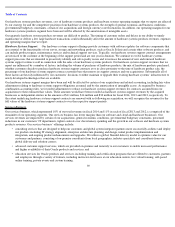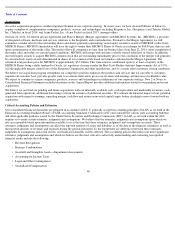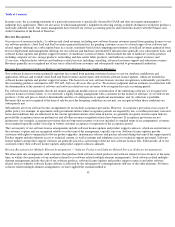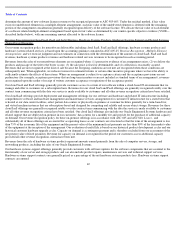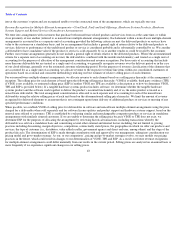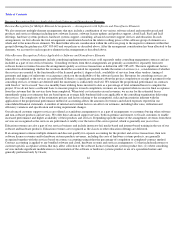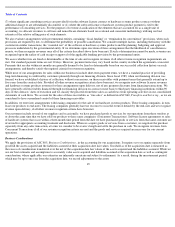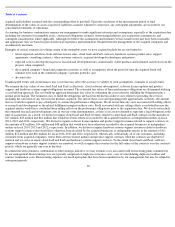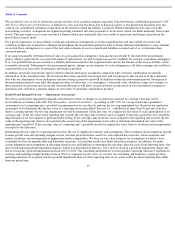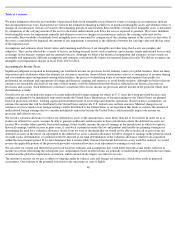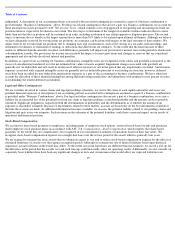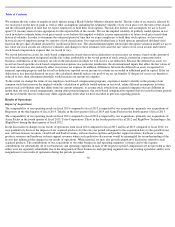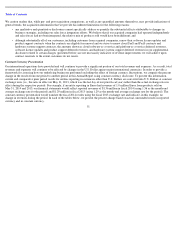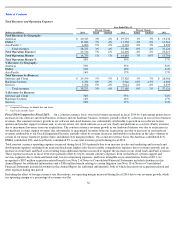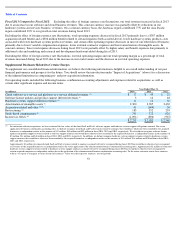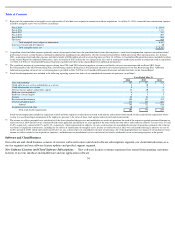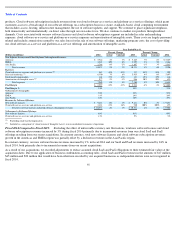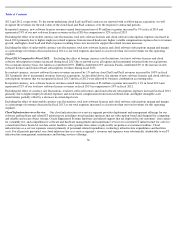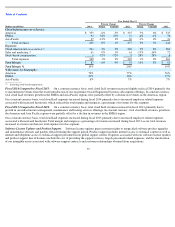Oracle 2013 Annual Report Download - page 51
Download and view the complete annual report
Please find page 51 of the 2013 Oracle annual report below. You can navigate through the pages in the report by either clicking on the pages listed below, or by using the keyword search tool below to find specific information within the annual report.
Table of Contents
We account for costs to exit or restructure certain activities of an acquired company separately from the business combination pursuant to ASC
420, Exit or Disposal Cost Obligations. A liability for costs associated with an exit or disposal activity is recognized and measured at its fair
value in our consolidated statement of operations in the period in which the liability is incurred. When estimating the fair value of facility
restructuring activities, assumptions are applied regarding estimated sub-lease payments to be received, which can differ materially from actual
results. This may require us to revise our initial estimates which may materially affect our results of operations and financial position in the
period the revision is made.
For a given acquisition, we may identify certain pre-acquisition contingencies as of the acquisition date and may extend our review and
evaluation of these pre-acquisition contingencies throughout the measurement period in order to obtain sufficient information to assess whether
we include these contingencies as a part of the fair value estimates of assets acquired and liabilities assumed and, if so, to determine their
estimated amounts.
If we cannot reasonably determine the fair value of a pre-acquisition contingency (non-income tax related) by the end of the measurement
period, which is generally the case given the nature of such matters, we will recognize an asset or a liability for such pre-acquisition contingency
if: (i) it is probable that an asset existed or a liability had been incurred at the acquisition date and (ii) the amount of the asset or liability can be
reasonably estimated. Subsequent to the measurement period, changes in our estimates of such contingencies will affect earnings and could have
a material effect on our results of operations and financial position.
In addition, uncertain tax positions and tax related valuation allowances assumed in connection with a business combination are initially
estimated as of the acquisition date. We reevaluate these items quarterly based upon facts and circumstances that existed as of the acquisition
date with any adjustments to our preliminary estimates being recorded to goodwill if identified within the measurement period. Subsequent to
the measurement period or our final determination of the tax allowance’s or contingency’s estimated value, whichever comes first, changes to
these uncertain tax positions and tax related valuation allowances will affect our provision for income taxes in our consolidated statement of
operations and could have a material impact on our results of operations and financial position.
Goodwill and Intangible Assets — Impairment Assessments
We review goodwill for impairment annually and whenever events or changes in circumstances indicate its carrying value may not be
recoverable in accordance with ASC 350, Intangibles—Goodwill and Other . According to ASC 350, we can opt to perform a qualitative
assessment to test a reporting unit’s goodwill for impairment or we can directly perform the two step impairment test. Based on our qualitative
assessment, if we determine that the fair value of a reporting unit is more likely than not (i.e., a likelihood of more than 50 percent) to be less
than its carrying amount, the two step impairment test will be performed. In the first step, we compare the fair value of each reporting unit to its
carrying value. If the fair value of the reporting unit exceeds the carrying value of the net assets assigned to that unit, goodwill is not considered
impaired and we are not required to perform further testing. If the carrying value of the net assets assigned to the reporting unit exceeds the fair
value of the reporting unit, then we must perform the second step of the impairment test in order to determine the implied fair value of the
reporting unit’s goodwill. If the carrying value of a reporting unit’s goodwill exceeds its implied fair value, then we would record an impairment
loss equal to the difference.
Determining the fair value of a reporting unit involves the use of significant estimates and assumptions. These estimates and assumptions include
revenue growth rates and operating margins used to calculate projected future cash flows, risk-adjusted discount rates, future economic and
market conditions and determination of appropriate market comparables. We base our fair value estimates on assumptions we believe to be
reasonable but that are unpredictable and inherently uncertain. Actual future results may differ from those estimates. In addition, we make
certain judgments and assumptions in allocating shared assets and liabilities to determine the carrying values for each of our reporting units. Our
most recent annual goodwill impairment analysis, which was performed on March 1, 2014, did not result in a goodwill impairment charge, nor
did we record any goodwill impairment in fiscal 2013 or 2012. Our consulting and hardware systems products reporting units have experienced
revenues and operating margin declines in fiscal 2014 as compared to prior years. As a result, our consulting and hardware systems products
reporting units may be at greater risk for goodwill impairment than our other reporting units if our actual results for these reporting units differ
from our projections.
47




